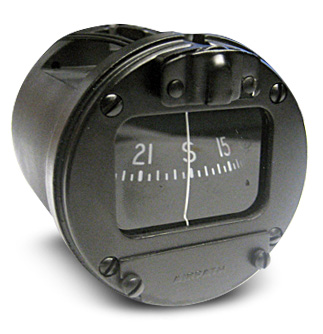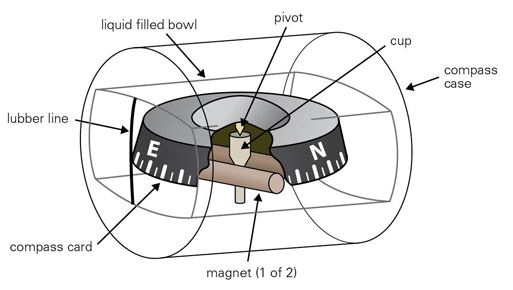However controversial, it is said that the magnetic compass first originated in China during the Qin Dynasty sometime between 212 and 206 B.C. as a Chinese fortune telling device. It wasn’t until the 13th Century that the magnetic compass began to be widely used as a directive aid during maritime and terrestrial navigation. But don’t worry, you are not required to know this information for your practical or knowledge test, I was just in the mood to fill your heads with some fun facts about the history of the magnetic compass.

Now let’s get to the important stuff, the things you will be required to know and understand. The magnetic compass is the most basic navigation tool installed in the cockpit and also a required instrument under Title 14 CFR Part 91 for all VFR and IFR flights. Above is a figure of one of the more common types of magnetic compasses you will find in your training aircraft. Internally the compass contains two small magnets attached to a metal float encased in a liquid similar to kerosene. The metal float is attached at a pivot able to move freely inside the liquid allowing each of the two magnets to align with the magnetic poles. Surrounding the float is a card containing the cardinal directions in letters N, E, S, W (“Never Eat Shredded Wheat” as someone once told me) with numbers marked for each 30 degrees between cardinal directions. For example N, 3, 6, E, as you can see the last digit “0” is removed from the direction card so 330 degrees would be displayed as 33. The front of the compass is glass and contains a line referred to as the “lubber line” the pilot reads the direction card as it relates to the lubber line. If W lines up with the lubber line you are flying on a westerly magnetic heading.

It is important to note that the magnetic compass does display some errors during changes in velocity and turning. You may have previously heard the term “UNOS” (“Undershoot North Overshoot South”), this is in relation to the northerly and southerly turning errors that a magnetic compass displays. When turning to a northerly heading the compass card will lead ahead of the turn so your turn should be stopped short of actually reaching the Northerly indication on the card. When turning to a Southerly heading the compass card lags and therefore your turn should pass through the desired heading prior to stopping your turn. As the aircraft’s proximity to the poles becomes less these errors become amplified.
Another acronym you may have heard is “ANDS” (Accelerate North Decelerate South). Acceleration/deceleration errors will be experience anytime the aircraft is on an easterly or westerly heading. When accelerating on one of these headings, the compass will initially show a turn to the north. As opposed to decelerating on an easterly or westerly heading the compass momentarily shows a turn to the South.
Both of the above discussed errors are caused in part by magnetic dip which is discussed in Chapter 7 of the Pilot’s Handbook of Aeronautical Knowledge. The above information is just a brief outline of the magnetic compass and I would encourage you read in detail about the variations and types of magnetic compasses and errors associated with each. You can find all relevant information in the Pilots Handbook of Aeronautical Knowledge and Instrument Flying Handbook both available on the ASA website.
Below are some study questions to assist you in preparing for your FAA Private Pilot Knowledge Exam, it is very likely you will see questions very similar to these on your actual knowledge test.
1. In the Northern Hemisphere, a magnetic compass will normally indicate initially a turn toward the west if
A—a left turn is entered from a north heading.
B—a right turn is entered from a north heading.
C—an aircraft is accelerated while on a north heading.
2. In the Northern Hemisphere, a magnetic compass will normally indicate a turn toward the north if
A—an aircraft is decelerated while on an east or west heading.
B—a left turn is entered from a west heading.
C—an aircraft is accelerated while on an east or west heading.
3. What should be the indication on the magnetic compass as you roll into a standard rate turn to the right from a south heading in the Northern Hemisphere?
A—The compass will initially indicate a turn to the left.
B—The compass will indicate a turn to the right, but at a faster rate than is actually occurring.
C—The compass will remain on south for a short time, then gradually catch up to the magnetic heading of the airplane.
4. During flight, when are the indications of a magnetic compass accurate?
A—Only in straight-and-level unaccelerated flight.
B—As long as the airspeed is constant.
C—During turns if the bank does not exceed 18°.




